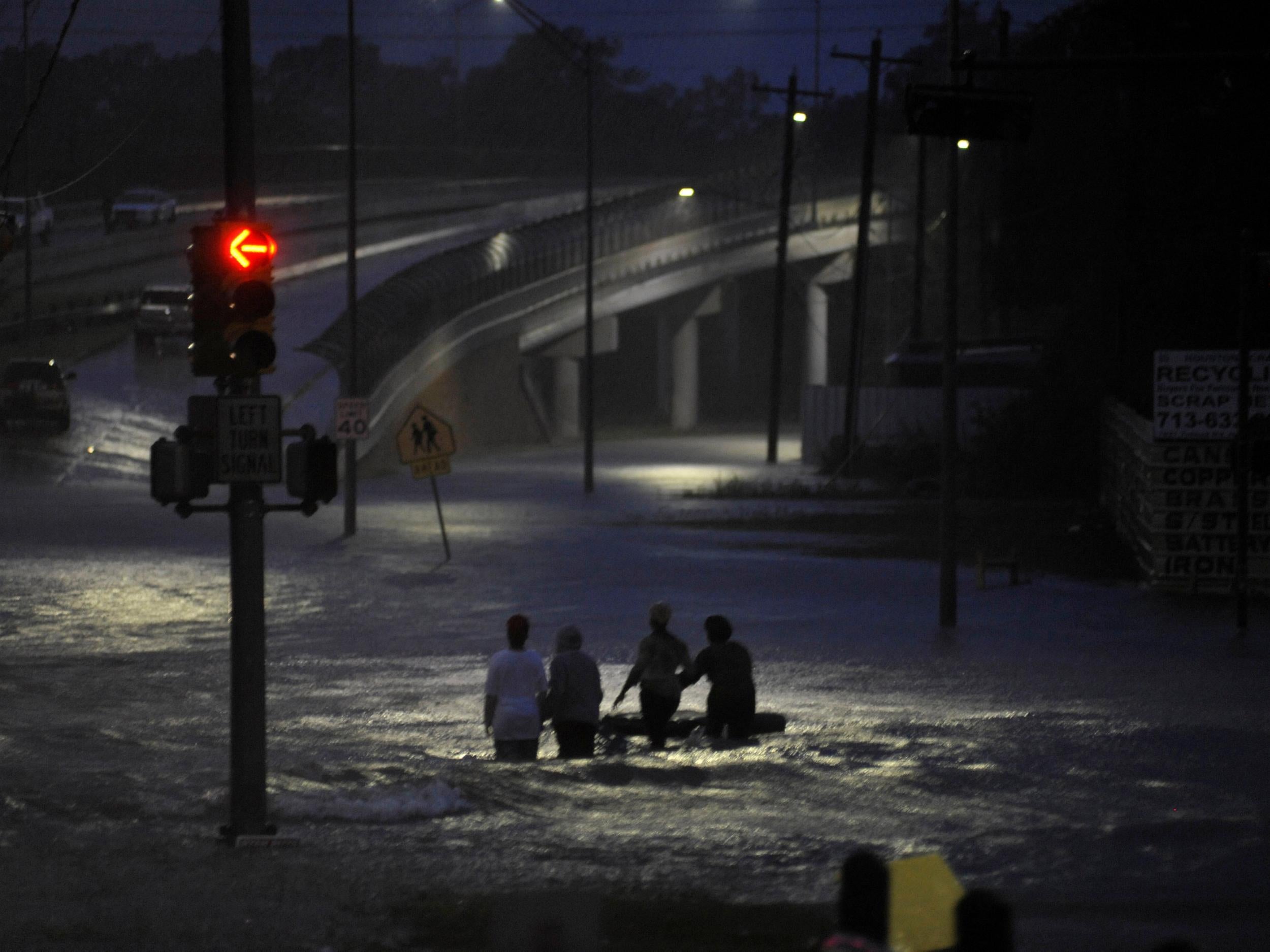No, climate change didn't cause the Hurricane Harvey disaster – society did
Many voting records in Texas are for lower taxes, for less government intervention, against tackling systemic inequities and against helping marginalised people help themselves. This choice actively creates the vulnerabilities which cause disasters

Your support helps us to tell the story
In my reporting on women's reproductive rights, I've witnessed the critical role that independent journalism plays in protecting freedoms and informing the public.
Your support allows us to keep these vital issues in the spotlight. Without your help, we wouldn't be able to fight for truth and justice.
Every contribution ensures that we can continue to report on the stories that impact lives

Kelly Rissman
US News Reporter
Weather and climate don’t cause disasters – vulnerability does. Perhaps counter-intuitively, this means that the widespread discussion as to whether the Hurricane Harvey disaster was caused by climate change or not becomes a dangerous distraction.
The hurricane was born off the coast of South America in mid-August and then tracked through the Gulf of Mexico, making landfall in the US on August 25. The storm surge and winds devastated coastal settlements, after which the storm stalled, dumping immense rainfall over Houston. At the time of writing, the confirmed death toll had just reached 14 and there are expectations that this will soon rise.
A disaster involving a hurricane cannot happen unless people, infrastructure and communities are vulnerable to it. People become vulnerable if they end up lacking knowledge, wisdom, capabilities, social connections, support or finances to deal with a standard environmental event such as a hurricane.
This can happen if lobbyists block tougher building codes, planning regulations, or enforcement procedures. Or if families can’t afford insurance or the cost of alternative accommodation if they evacuate. Or if limited hurricane experience induces a sense of apathy.
Often, people with disabilities rarely have their needs met when away from home. Fear of harassment or assault could stop others from entering a communal shelter. Legal or undocumented immigrants might not understand warnings and might fear the prospect of detention if they seek help.
These possible scenarios represent reasons why people in Texas might end up and remain in harm’s way. Anecdotes point to all these issues having played a part during Harvey, but only careful research in the months ahead will be able to confirm or refute them. It is nevertheless such vulnerability issues that cause the disaster. None relate to the hurricane’s physical characteristics.
Climate change
Yes, climate change can and does influence hurricanes. The ocean’s temperature – to a certain degree – drives hurricane intensity, especially the coastal flooding level and the amount of rainfall. If the Gulf of Mexico was warmer than usual, or if some atmospheric winds were weaker than usual, then part of Harvey’s strength might be attributable to human-caused climate change. Harvey stalling above Houston might also be linked to climate change’s effects due to changing wind patterns.
But climate change does not affect people’s vulnerabilities to the hurricane. Neither the climate nor the hurricane’s characteristics made Houston an industrial centre of 2.3m people (2017 estimate), an increase of 40% since 1990. They did not force Texans to build along the coast or in floodplains without adequate measures, as occurs around the US. They did not pave over green spaces leading to reduced rainfall absorption. And they did not create the ingrained racism and desperate social inequities prevalent across the state.
In fact, storms striking Texas represented problems long before human-caused climate change appeared. One of the deadliest storms in US history occurred in 1900, when a hurricane swept ashore over Galveston, killing more than 6,000 people – more than triple Hurricane Katrina’s death toll in 2005. We often do not know details about the strength of past hurricanes or the height of their floodwaters. But we do know that fewer people lived – and much less infrastructure lay – along the storms’ paths. Yet tragedies such as Galveston still manifested, irrespective of climate change.
These historical disasters – and more recent ones such as Hurricanes Katrina and Rita in 2005 – spurred the disaster prevention measures which saved many lives but which were not implemented fully in Texas. This left far too many people vulnerable and in danger.
‘Turn Around, Don’t Drown’
The first mandatory evacuation notice in Texas for Harvey was issued about 36 hours before the hurricane’s landfall. The ability to forecast hurricane tracks and traits, to communicate the necessary responses and to plan for masses of people moving have emerged from decades of dedicated science.
Compared to the 1900 Galveston disaster, thousands of lives were saved by scientists and government officials collaborating to serve those who were vulnerable. Many structures withstood Harvey’s 200+ km/h wind gusts with debris because engineers and lawyers wrote building codes while the government enforced the regulations. The “Turn Around, Don’t Drown” message to stay out of floodwater comes from combining research and experience on flood physics and communication science.
But the news is not all good, especially since much of this lifesaving work is currently undergoing budget cuts.
And politics created further vulnerability. State and local leaders disagreed about evacuating Houston. Development in the city’s floodable areas had been encouraged to support the oil-fuelled economy, increasing both the population living in floodplains and the paved surfaces which augments run-off. As usual in disasters, poor and marginalised people seem to be bearing the brunt of the impacts, despite plenty of science showing the importance of social services for fostering self-help and for collectively avoiding disasters.
All this work prevents deaths during any hurricane, irrespective of climate change. Climate change might have augmented Harvey’s rainfall, storm surge, or wind. If not, Texas would still have implemented exactly the same measures to reduce the disaster’s effects. And Texas would still have had exactly the same political difficulties propping up the remaining vulnerability.
Disasters are not natural
Hurricane Harvey was an expected natural event, even if potentially modified or exacerbated by climate change. The Hurricane Harvey disaster was caused entirely by society creating and perpetuating vulnerability to these natural events.
Because vulnerability is not natural, many disaster researchers avoid the phrase “natural disaster”. Nor must hurricane disasters be our natural state of affairs, even though hurricanes have always happened. A hurricane need not become a hurricane disaster – but society let a disaster happen.
To help those affected recover quickly, Texas needed improved pre-disaster mechanisms such as more widespread insurance coverage and more widely available social services targeted at the most needy. Society must permit affordable insurance, without bankrupting the companies. Society needs regulators to ensure that payouts are reasonable and prompt while identifying claimant fraud. Society requires sufficiently skilled and resourced authorities to support everyone affected in helping themselves, no matter their background or abilities.
Many voting records in Texas are for lower taxes, for less government intervention, against tackling systemic inequities and against helping marginalised people help themselves. This choice actively creates the vulnerabilities which cause disasters. It is an ideological choice to vote for creating disaster vulnerability and voters have the right to do so. The consequences are known based on decades of disaster science.
Blaming climate change, or even just the weather, for the hurricane disaster distracts from individuals’ and society’s responsibility for where we live, how we live and how we support people who cannot help themselves. This vulnerability, not nature and not climate change, causes hurricane disasters.
Ilan Kelman is a researcher on risk and disaster reduction at UCL. This piece originally appeared on The Conversation
Join our commenting forum
Join thought-provoking conversations, follow other Independent readers and see their replies
Comments